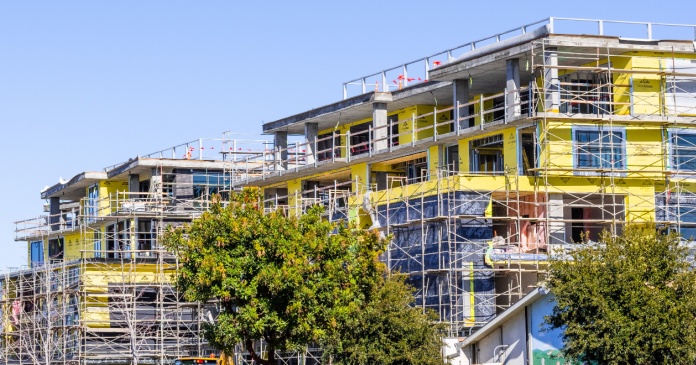In fact, AIMCO President, CFO and Chief Investment Officer David Robertson told an audience at BMO’s North American Real Estate Conference on Sept. 10 that the job loss in the Big Apple’s financial services world is only half the size predicted towards the end of last year.
“We expected things would be worse in New York in general and expected the market would lose some 200,000 financial services jobs by this point. I think that number is closer to 90,000 and there’s obviously a lot of hiring going on,’ said Robertson. AIMCO’s nationwide portfolio includes just over 154,500 units in 950 apartment communities spread from coast to coast and in Puerto Rico, with 956 of the conventional units in 22 properties in Manhattan that contributed 2.6 percent of the company’s NOI in Q2 2009.
AvalonBay Communities
AvalonBay VP of Operations Leo Horey was equally optimistic when he reported, during the mostly bi-coastal apartment REIT’s Q2 2009 earnings call, that New York and Northern New Jersey were experiencing pressure on the rental side, but occupancies have held up reasonably well, despite the number of financial services jobs lost in those markets.
Horey, whose operations team oversees AvalonBay’s entire portfolio of 50,500 units in 174 apartment communities that are concentrated mostly on the East and West Coasts, with 896 units in the Chicago area, reminded the analysts listening in on AvalonBay’s Q2 earnings call that the REIT’s same-store 6,307-unit New York Metro portfolio includes only assets in Long Island City and Westchester and Rockland counties and contains no Manhattan assets. Speaking more broadly about the REIT’s New York metropolitan area portfolio, Horey said AvalonBay’s New York City assets are stable.
“Those assets are exceeding 97 percent occupancy and, while, as we’ve discussed the last couple of quarters, the rents are absolutely down 15 percent, we are seeing some stability there, where concessions that have been offered are either flat or coming down a little bit,’ he said.
Moving to the other markets around the city, Stamford, Conn., he said, is more challenged for a couple of reasons. Not only is that sub-market heavily dependent on financial service jobs, but is also losing renters as people are being drawn back into New York City by reduced rents and increasing concessions, with a similar situation occurring along the Jersey waterfront, Horey said, in answer to an analyst’s question about market health.
“I think part of your question about New York is a question we’ve had for many quarters, where people have expected New York to fall off the proverbial cliff in terms of performance, CEO Bryce Blair told the analyst, acknowledging, as did Horey, that the market may be weak, but not as weak as many others.
Looking on a relative basis across the nation, as of the end of July, New York was expected to lose about 2.5 percent of its jobs this year, compared to about four percent job loss nationally. And most of AvalonBay’s California markets already were seeing job losses from four percent to in excess of five percent by mid-year, he said.
“So, I think we all tend to get a little too myopic on New York, thinking about the financial services and the impact of the weakness of the financial services sector on New York, which is a significant component of that economy, but still not the key driver,’ said Blair.
Those finance, insurance and real estate jobs comprise about six percent of all jobs in the country. “In our portfolio, it’s about nine percent of our residents’ employment and, in New York, it’s about 18 percent. That’s significantly higher than the national average, but it’s still obvious that the majority of our residents are not employed in that sector,’ Blair said.
The REIT started lease-up in September at the 631-unit, $307 million Avalon Fort Greene that broke ground in Q4 2007 in Brooklyn, with completion scheduled for Q1 2011, not far from Forest City’s 365-unit, 34-story apartment community that is underway at 80 DeKalb Avenue and Equity Residential’s recently topped-off, 491-unit The Booklyner.
Equity ResidentialEquity Residential’s 145,000-unit, nationwide portfolio that includes 6,246 stabilized units in the New York Metro currently is in lease-up on around 1,000 more apartments in recently completed skyscrapers in Brooklyn and Jersey City. The REIT has seen a basically stable revenue stream there since the beginning of the year, after watching rents erode around nine percent, when the economy tanked last year, CEO David Neithercut said during another panel discussion at the BMO conference, echoing what Executive VP of Operations Fred Tuomi told analysts during the REIT’s Q2 2009 earnings call at the end of July.
“With everything going on there, you would expect to have a worse report. I am very satisfied with how New York has performed so far through this cycle. This summer has been particularly encouraging. We had a very strong June demand. Our leasing was up, our occupancies up and our net effective asking rents recovered dramatically during the month of June,’ Tuomi said. All of Equity Residential’s penthouses were full and occupancy at the REIT’s assets in the market stood at 95.7 percent as of July 30.
Post Properties
Atlanta-based apartment REIT Post Properties, which owns and operates nearly 20,000 apartments in 55 communities in major Southeastern and Texas markets, with a few assets in Washington, D.C., entered the NYC market about seven years ago through development partnerships in Manhattan that resulted in construction of the 138-unit Post Luminaria and the 199-unit Post Toscana. The REIT briefly considered offering to trade its New York City properties for comparable assets in Washington, D.C., in 2005, but changed its mind mid-year in response to then-improving fundamentals in Manhattan.
For a while, before the condo bubble burst, there was some speculation among industry watchers that the 38-year-old company that began to convert a number of its assets to condos in 2005, might do the same at the two Manhattan assets. But Post hung onto the 337 units as rentals that produced seven percent of the company’s overall NOI in Q2.
At the end of July, Post was reporting new lease rates 10 to 12 percent less than during the same time last year, with pricing driving demand, explained Tom Wilkes, president of Post Apartment Management, the entity that oversees day-to-day operations at the REIT’s communities. Physical occupancy at Post’s two Manhattan assets averaged 95.3 percent at the end of July, but economic occupancy was just 92.8 percent, driven down by the concessions the market demands for new leases.
Wilkes includes New York in the group of three of Post’s nine markets he expects will be the REIT’s worst performers for the second half of this year — Atlanta, Charlotte and New York. Average rent at Post’s Manhattan assets is $3,843 a month, nearly three times as much as renting a $1,339 Post apartment in Orlando, the market with the next highest average new lease rents in the portfolio, and more than triple the $1,108 a month average it costs to live in a Post apartment in Charlotte. But all three markets are expected to see a bit more than the two percent sequential decline in revenues across Post’s entire portfolio, Wilkes predicted.
“Although we held up relatively well through the first half of the year, we expect leasing conditions to deteriorate in the second half of 2009. In our other markets, our revenue management system drives our daily pricing and we rarely use upfront concessions. However, New York is a concession-driven market and we expect the concessions to pick up in the second half of the year,’ he said.
Post’s concessions, like Equity Residential’s, currently are running around one month free on the companies’ New York apartments.
Putting it into perspective
Manhattan’s large market-rate apartment inventory will expand by 3,180 units this year, the greatest supply addition in the borough since 2005, putting further pressure on rents and probably pushing concessions even higher. Meanwhile, Manhattan businesses have trimmed payrolls by 2.7 percent, with layoffs most severe among white-collar workers, and more job loss is predicted by Marcus & Millichap for the balance of the year. The nation’s largest real estate brokerage firm also predicted, in its September market report on Manhattan, that the shadow market will grow darker with the addition of roughly 3,800 new for-sale units to the housing mix, including 460 condominiums in Upper Manhattan.
The prognosis for Brooklyn includes persistent job losses to a total of around 17,000 newly unemployed workers for the year, resulting in decreased household budgets and vacancy in large, market-rate apartment properties increasing 110 bps to 2.9 percent, while asking rents are forecast to retreat three percent.
But, when put into perspective, the Big Apple doesn’t look so bad. In Orlando, for example, Marcus & Millichap foresees that lack of demand will push vacancy up to 11.2 percent, while effective rents are projected to decrease 4.4 percent. And, California’s formerly robust Orange County is looking at a 5.5 percent reduction in rents for the year, driven by delivery of around 3,800 new units, as a number of apartment communities with 300+ units are completed, expanding local inventory by 1.9 percent.
The addition of almost as many new apartments this year in Charlotte, where 22,000 workers are expected to join the ranks of the unemployed this year — the most workers cut in the Queen City in any year this decade — will push vacancy to nearly 10 percent there. Additions to apartment supply this year in Charlotte will exceed last year’s completions by nearly 60 percent, resulting in the second consecutive year of vacancy increase, according to Marcus & Millichap.
Those bleak outlooks are more the norm than the exception across the country, making the Big Apple more appealing to those investors with an appetite for apartments, as the transaction market begins to thaw and the acquisition scene, which until recently was dominated by regional players looking for small deals, is seeing the return of institutional investor interest.
One of the newest heavy hitters targeting the New York City market is a joint venture formed by apartment REIT UDR, Inc. and Kuwait Finance House in August with plans to invest up to $450 million in multifamily properties over the next couple of years, giving UDR, which currently has no presence in the Big Apple, the ability to expand the company’s nearly 45,000-unit, coast-to-coast portfolio into new high-barrier markets, including New York City.
















